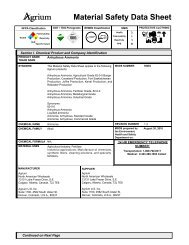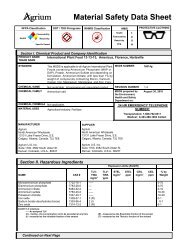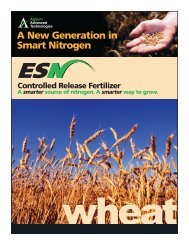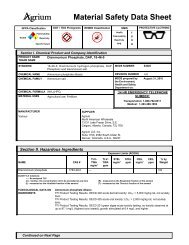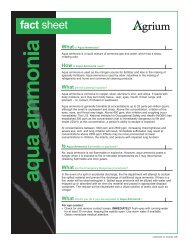You also want an ePaper? Increase the reach of your titles
YUMPU automatically turns print PDFs into web optimized ePapers that Google loves.
Material Safety Data Sheet<br />
NFPA Classification<br />
DOT / TDG Pictograms<br />
WHMIS Classification<br />
HMIS<br />
PROTECTIVE CLOTHING<br />
Health<br />
0<br />
0 Flammability<br />
0 Reactivity<br />
Specific Hazard<br />
Health<br />
Flammability<br />
Reactivity<br />
PPE<br />
1<br />
0<br />
0<br />
A<br />
Section I. Chemical Product and Company Identification<br />
PRODUCT NAME/ Urea, Prilled Feed Grade 46-0-0<br />
TRADE NAME<br />
SYNONYM<br />
Prilled Feed Grade 46-0-0 Urea<br />
<strong>MSDS</strong> NUMBER:<br />
14032<br />
CHEMICAL NAME<br />
CHEMICAL FAMILY<br />
CHEMICAL FORMULA<br />
MATERIAL USES<br />
Carbamide<br />
Aliphatic amide (Aliphatic.)<br />
CO(NH 2) 2<br />
Agricultural industry: Fertilizer, feed suppliment.<br />
Industrial applications: Manufacture of specialty<br />
fertilizers. Manufacture of chemicals.<br />
REVISION NUMBER 4.9<br />
<strong>MSDS</strong> prepared by<br />
the Environment,<br />
Health and Safety<br />
Department on:<br />
August, 2010<br />
24 HR EMERGENCY TELEPHONE<br />
NUMBER:<br />
Transportation: 1-800-792-8311<br />
Medical: 0-303-389-1653 Collect<br />
MANUFACTURER<br />
<strong>Agrium</strong> U.S. Inc.<br />
Suite 1700, 4582 South Ulster St.<br />
Denver, Colorado, U.S.A.<br />
80237<br />
SUPPLIER<br />
<strong>Agrium</strong><br />
North American Wholesale<br />
13131 Lake Fraser Drive, S.E.<br />
Calgary, Alberta, Canada, T2J 7E8<br />
<strong>Agrium</strong> U.S. Inc.<br />
Suite 1700, 4582 South Ulster St.<br />
Denver, Colorado, U.S.A., 80237<br />
Section II. Composition / Information on Ingredients<br />
NAME CAS #<br />
TLV-<br />
TWA<br />
mg/m 3<br />
Exposure Limits (ACGIH)<br />
STEL<br />
mg/m 3<br />
CEIL<br />
mg/m 3<br />
% by<br />
Weight<br />
Urea 57-13-6 --- ~98<br />
Urea reaction products with<br />
68611-64-3 --- 9,100 mg/L<br />
Acute toxicity to invertibrates, Daphnia, EC 50 (24kr) >10,000 mg/L<br />
Acute toxicity to birds, pigeon, LDLo = 16,000 mg/kg subcutaneous<br />
Continued on Next Page
Urea, Prilled Feed Grade 46-0-0 Page Number: 2<br />
Toxicity to algae, Scenedesmus quadricauda, cell multiplication inhibition, TT(192 hr) > 10,000 mg/L<br />
Section III. Hazards Identification.<br />
POTENTIAL ACUTE HEALTH<br />
EFFECTS<br />
POTENTIAL CHRONIC<br />
HEALTH EFFECTS<br />
Not considered to be toxic for humans under normal conditions of use. However, in keeping<br />
with good industrial hygiene practises, exposure to any chemical should be kept to a<br />
minimum. This product may cause irritation to the eyes and skin due to mechanical action.<br />
CARCINOGENIC EFFECTS: NONE by ACGIH, EPA, IARC, OSHA.<br />
MUTAGENIC EFFECTS: NONE by ACGIH, EPA, IARC, OSHA.<br />
TERATOGENIC EFFECTS: NONE by ACGIH, EPA, IARC, OSHA.<br />
There is no known effect from chronic exposure to this product. Urea is approved as a food<br />
and cosmetic additive, is an ingredient in clinical preparations, and is a normal human<br />
metabolite found in urine.<br />
Section IV. First Aid Measures<br />
EYE CONTACT<br />
May cause eye irritation due to mechanical action. Immediately flush eyes with running water<br />
for at least 15 minutes, keeping eyelids open. Obtain medical attention if irritation persists.<br />
MINOR SKIN CONTACT<br />
EXTENSIVE SKIN CONTACT<br />
May cause skin irritation. Wash contaminated skin with soap and water. Cover dry or irritated<br />
skin with a good quality skin lotion. If irritation persists, seek medical attention.<br />
No additional information.<br />
MINOR INHALATION<br />
SEVERE INHALATION<br />
SLIGHT INGESTION<br />
EXTENSIVE INGESTION<br />
Repeated or prolonged inhalation of dust may lead to respiratory irritation. Loosen tight<br />
clothing around the individual's neck and waist. Allow the person to rest in a well ventilated<br />
area. Obtain medical attention if irritation persists.<br />
No additional information.<br />
Remove dentures if any. If conscious, have person drink several glasses of water or milk and<br />
induce vomiting. Never give anything by mouth to an unconscious person. Lower the head so<br />
that the vomit will not reenter the mouth and throat. Obtain medical attention.<br />
No additional information.<br />
Section V. Fire and Explosion Data<br />
THE PRODUCT IS<br />
Non-flammable.<br />
AUTO-IGNITION<br />
TEMPERATURE<br />
FLASH POINT<br />
FLAMMABILITY LIMITS<br />
PRODUCTS OF<br />
COMBUSTION<br />
FIRE HAZARD IN THE<br />
PRESENCE OF VARIOUS<br />
SUBSTANCES<br />
EXPLOSION HAZARD IN THE<br />
PRESENCE OF VARIOUS<br />
SUBSTANCES<br />
FIRE FIGHTING MEDIA AND<br />
INSTRUCTIONS<br />
Not applicable.<br />
Not applicable.<br />
Not applicable.<br />
Not applicable. Material will not burn. Undergoes thermal decomposition at elevated<br />
temperatures to produce solid cyanuric acid and release toxic and combustible gases<br />
(ammonia, carbon dioxide, and oxides of nitrogen).<br />
Not applicable.<br />
May be explosive on contact with halogens such as chlorine. Non-explosive from open flames<br />
and sparks, shocks, heat, oxidizing materials, combustible materials, organic materials,<br />
metals, acids, alkalis, or moisture.<br />
Non-flammable. Material will not burn. Undergoes thermal decomposition at elevated<br />
temperatures to release toxic and combustible gases (ammonia, carbon dioxide, and oxides<br />
of nitrogen). If fumes or gases are suspected to be present, fire fighters should wear selfcontained<br />
breathing apparatus. Use extinguishing media suitable for surrounding materials.<br />
Continued on Next Page
Urea, Prilled Feed Grade 46-0-0 Page Number: 3<br />
SPECIAL REMARKS ON<br />
FIRE HAZARDS<br />
Flammable/toxic gases will form at elevated temperatures by thermal decomposition. When<br />
exposed to heat, ammonia is released.<br />
SPECIAL REMARKS ON<br />
EXPLOSION HAZARDS<br />
May be explosive when mixed with hypochlorites. Forms nitrogen trichloride which may<br />
explode spontaneously in air.<br />
Section VI. Accidental Release Measures<br />
SMALL SPILL<br />
LARGE SPILL<br />
Use appropriate tools to put the spilled solid in a suitable container for intended use or<br />
disposal.<br />
Prevent additional discharge of material, if possible to do so without hazard. Prevent spills<br />
from entering sewers, watercourses, wells, etc. Product will promote algae growth which<br />
may degrade water quality and taste. Notify downstream water users. Recover and place<br />
material in suitable containers for recycle, reuse, or disposal. Ensure disposal complies with<br />
government requirements and local regulations.<br />
Section VII. Handling and Storage<br />
PRECAUTIONS<br />
STORAGE<br />
If user operations generate dust, fume or mist, use ventilation to keep exposure to airborne<br />
contaminants below the exposure limit. Keep out of reach of children.<br />
Store in a dry, cool and well ventilated area. Keep away from incompatible materials. Do not<br />
blend or store in contact with ammonium nitrate. Dry urea and dry ammonium nitrate will<br />
react together to give produce a slurry.<br />
Section VIII. Exposure Controls/Personal Protection<br />
ENGINEERING CONTROLS Use process enclosures, local exhaust ventilation, or other engineering controls to keep<br />
airborne levels below recommended exposure limits. If user operations generate dust,<br />
ventilation to keep exposure to airborne contaminants below the exposure limit.<br />
PERSONAL PROTECTION<br />
PERSONAL PROTECTION IN<br />
CASE OF LARGE RELEASE<br />
The selection of personal protective equipment varies, depending upon conditions of use.<br />
Wear appropriate respiratory protection for dust/mist when ventilation is inadequate. A filtering<br />
facepiece dust mask is recommended for most applications if respiratory protection is<br />
needed. Where skin and eye contact may occur as a result of brief periodic exposures, wear<br />
long sleeved clothing, coveralls, chemical resistant gloves, and safety glasses with side<br />
shields.<br />
No additional information.<br />
EXPOSURE LIMITS<br />
AIHA Workplace Environmental Exposure Limits: 10 mg/m 3 TWA for Urea as inhalable dust.<br />
OSHA PEL: 15 mg/m3 for Particulates Not Otherwise Regulated.<br />
Federal, State or Provincial exposure limits may vary by jurisdiction. Consult local authorities<br />
for acceptable exposure limits in your area.<br />
Section IX. Physical and Chemical Properties<br />
PHYSICAL STATE AND<br />
APPEARANCE<br />
pH (10% SOLN/WATER)<br />
BOILING POINT<br />
MELTING POINT<br />
SPECIFIC GRAVITY g/cc<br />
VAPOR PRESSURE<br />
Solid.<br />
MOLECULAR WEIGHT 60.06<br />
CRITICAL TEMPERATURE<br />
8.8<br />
Decomposes at 135 o C.<br />
132.7°C (270.9°F)<br />
Not applicable.<br />
0.76 (Water = 1)<br />
BULK DENSITY<br />
kg/m 3 ; lbs/ft 3 Loose: 760 kg/m 3 ; 47 lbs/ft 3 ;<br />
Tapped: 809 kg/m 3 ; 50 lbs/ft 3<br />
0.08 kPa<br />
COLOR<br />
ODOR<br />
ODOR<br />
THRESHOLD<br />
TASTE<br />
VOLATILITY<br />
SOLUBILITY<br />
DISPERSION<br />
PROPERTIES<br />
White.<br />
Odorless to slightly ammoniacal.<br />
17 PPM as ammonia.<br />
Saline.<br />
Not available.<br />
Soluble in cold or hot water.<br />
Easily dispersed in any proportion in<br />
cold water and hot water.<br />
Continued on Next Page
Urea, Prilled Feed Grade 46-0-0 Page Number: 4<br />
VAPOR DENSITY<br />
Not available.<br />
WATER/OIL DIST.<br />
COEFF.<br />
Soluble in water.<br />
Section X. Stability and Reactivity Data<br />
STABILITY<br />
The product is stable.<br />
INSTABILITY<br />
TEMPERATURE<br />
CONDITIONS OF<br />
INSTABILITY<br />
INCOMPATABILITY WITH<br />
VARIOUS SUBSTANCES<br />
CORROSIVITY<br />
Not available.<br />
No additional remark.<br />
Reactive with halogens. Slightly reactive with oxidizing agents, reducing agents, acids, alkalis,<br />
moisture. Non-reactive with combustible materials, organic materials, most metals.<br />
Corrosive to mild steel. Slightly corrosive to aluminum, zinc, or copper. Non-corrosive to<br />
glass, 304 or 316 stainless steel.<br />
SPECIAL REMARKS ON<br />
REACTIVITY<br />
SPECIAL REMARKS ON<br />
CORROSIVITY<br />
Absorbs moisture from the air. Hygroscopic; keep container tightly closed.<br />
Avoid contact with moisture. Slow hydrolysis may produce acids corrosive to metals. Contact<br />
your sales representative or a metallurgical specialist to ensure compatability with system<br />
equipment.<br />
Section XI. Toxicological Information<br />
SIGNIFICANT ROUTES OF<br />
EXPOSURE<br />
TOXICITY TO ANIMALS<br />
Ingestion. Inhalation.<br />
Acute oral toxicity (LD50): 14300 mg/kg (Rat.).<br />
Under controlled feeding conditions, urea is used as a nutritional supplement in cattle and<br />
other animals. The toxic dose in cattle given urea for the first time is considered to be 0.45<br />
g/kg or a total of 100-200 g. Mature bullocks can digest as much as 400 g a day without ill<br />
effect. As little as 50 g may cause adverse effects in cattle not accustomed to it.<br />
SPECIAL REMARKS ON<br />
TOXICITY TO ANIMALS<br />
OTHER EFFECTS ON<br />
HUMANS<br />
SPECIAL REMARKS ON<br />
CHRONIC EFFECTS ON<br />
HUMANS<br />
SPECIAL REMARKS ON<br />
OTHER EFFECTS ON<br />
HUMANS<br />
Animal Antidote and Emergency Treatment:<br />
In animals, the cold water - acetic acid treatment may work. The adult cow is given 19-38<br />
liters cold water and 3.8 liters of 5% acetic acid (vinegar) orally. This treatment limits<br />
absorption of ammonia from the rumen by diluting the rumen contents and slowing the rate of<br />
hydrolysis of urea by decreasing rumen pH and temperature. The treatment also promotes<br />
urine flow that, if maintained by fluid therapy, may assure recovery from urea toxicity.<br />
Gaseous or fluid bloat should be relieved before pumping water into the rumen. Consult your<br />
veterinarian immediately.<br />
Low toxicity for humans or animals.<br />
WARNING!<br />
May be harmful to livestock if ingested without adequate mixing. If used for the manufacture<br />
of feeds for livestock, mix thoroughly by making a preblend with one of the ingredients, then<br />
adding and mixing the preblend with all other ingredients. Equivalent protein from Urea should<br />
not exceed one-third of the protein in the mixture.<br />
Our data base contains no additional remark on the toxicity of this product<br />
No effects.<br />
May cause irritation of the mucous membranes and upper respiratory tract.<br />
Continued on Next Page
Urea, Prilled Feed Grade 46-0-0 Page Number: 5<br />
Section XII. Ecological Information<br />
ECOTOXICITY<br />
BOD and COD<br />
Very low toxicity for humans or animals. Will slowly release ammonia and degrade to nitrate.<br />
Ammonia is a toxic hazard to fish. However, ammonia release is slow making urea much<br />
less toxic than ammonium salts. Aquatic toxicity tests indicate 24 Hr exposure at 16,000<br />
mg/L of urea did not kill Creek Chubs. Urea ingestion may be toxic to mammals and birds at<br />
body burdens of several thousands of mg/kg. Urea is used in small quantities as as a feed<br />
suppliment for livestock. Non-persistent. Non-cumulative when applied using normal<br />
agricultural practises. U.S. D.O.T.: This material NOT listed as a Marine pollutant.<br />
Not available.<br />
PRODUCTS OF<br />
DEGRADATION<br />
TOXICITY OF THE<br />
PRODUCTS OF<br />
DEGRADATION<br />
SPECIAL REMARKS ON THE<br />
PRODUCTS OF<br />
DEGRADATION<br />
Ammonia, carbon dioxide and water.<br />
The product itself and its products of degradation are not harmful under normal conditions of<br />
use. Avoid spills or releases to watercourses.<br />
Urea will promote algae growth which may degrade water quality and taste. Notify<br />
downstream water users. Will dissolve and disperse in water. Reclaiming material may not<br />
be viable.<br />
Section XIII. Disposal Considerations<br />
WASTE DISPOSAL OR<br />
RECYCLING<br />
Recover and place material in a suitable container for intended use or disposal. Ensure<br />
disposal complies with government requirements and local regulations.<br />
Section XIV. Transport Information<br />
DOT / TDG CLASSIFICATION<br />
Not controlled under DOT (US) or TDG (Canada).<br />
PIN and Shipping Name<br />
SPECIAL PROVISIONS FOR<br />
TRANSPORT<br />
DOT (U.S.A) (Pictograms)<br />
Not applicable.<br />
Not applicable.<br />
Section XV. Other Regulatory Information and Pictograms<br />
OTHER REGULATIONS<br />
OTHER CLASSIFICATIONS<br />
CANADIAN ENVIRONMENTAL PROTECTION ACT (CEPA): This product is on the Domestic<br />
Substances List (DSL) and acceptable for use under the provisions of CEPA.<br />
EINECS: This product is on the European Inventory of Existing Commercial Chemical Substances.<br />
CERCLA/SUPERFUND, 40 CFR 117,302: This product contains no Reportable Quantity (RQ)<br />
Substances.<br />
This product does not contain Section 313 reportable ingredients.<br />
This product is not considered as a priority pollutant as regulated under the Clean Water Act.<br />
TSCA (Toxic Substance Control Act): This product is listed on the TSCA Inventory.<br />
CALIFORNIA PROPOSITION 65: This product contains no chemicals known to the State of California<br />
to cause cancer, birth defects, or other reproductive harm.<br />
This product has been classified in accordance with the hazard criteria of the Controlled Products<br />
Regulations and is not subject to control under WHMIS (Canada), or the Hazcom Standard (US).<br />
HCS (U.S.A.)<br />
DSCL (EEC)<br />
Not controlled under the HCS (United States). Exempt under<br />
1910.1200(b)(6)(x).<br />
Not controlled under DSCL (Europe).<br />
Continued on Next Page
Urea, Prilled Feed Grade 46-0-0 Page Number: 6<br />
National Fire Protection<br />
Association (U.S.A.)<br />
Hazards presented under acute emergency<br />
conditions only:<br />
Health<br />
0<br />
0<br />
0<br />
Fire Hazard<br />
Reactivity<br />
Specific Hazard<br />
TDG (Pictograms -<br />
Canada)<br />
DSCL (Europe)<br />
(Pictograms)<br />
ADR (Europe)<br />
(Pictograms)<br />
Section XVI. Other Information<br />
REFERENCES<br />
OTHER SPECIAL<br />
CONSIDERATIONS<br />
FOR FURTHER SAFETY, HEALTH, OR<br />
ENVIRONMENTAL INFORMATION ON<br />
THIS PRODUCT, CONTACT<br />
NOTICE TO READER<br />
-Transportation of Dangerous Goods Act and Clear Language Regulations, current revision.<br />
-Canada Gazette Part II, Vol. 122, No. 2 Registration SOR/88-64 31 December, 1987<br />
Hazardous Products Act "Ingredient Disclosure List".<br />
-Domestic Substances List, Canadian Environmental Protection Act.<br />
-29 CFR Part 1910<br />
-33 CFR Parts 151, 153, 154, 156<br />
-40 CFR Parts 1-799<br />
-46 CFR Part 153<br />
-49 CFR Parts 1-199<br />
-American Conference of Governmental Industrial Hygienists, Threshold Limit Values for<br />
Chemical Substances, 2008.<br />
-NFPA 704, National Fire Codes Online, National Fire Protection Association, current edition at<br />
time of <strong>MSDS</strong> preparation.<br />
-Corrosion Data Survey, Sixth Edition, 1985, National Association of Corrosion Engineers<br />
ERG2004 Emergency Response Guidebook;<br />
CHRIS: Hazardous Chemical Data: U.S. Department of Transportation, U.S. Coast Guard,<br />
Washington,D.C.;<br />
HSDB: Hazardous Substances Data Bank. National Library of Medicine, Bethesda, Maryland;<br />
IRIS: Integrated Risk Information System. U.S. Environmental Protection Agency, Washington,<br />
D.C.;<br />
NIOSH: Pocket Guide to Chemical Hazards. National Institute for Occupational Safety and<br />
Health, Cincinnati, Ohio;<br />
OHM/TADS: Oil and Hazardous Materials Technical Assistance Data System. U.S.<br />
Environmental Protection Agency, Washington, D.C.;<br />
RTECS®: Registry of Toxic Effects of Chemical Substances. National Institute for Occupational<br />
Safety and Health, Cincinnati, Ohio<br />
-Veterinary Pharmacology and Therapeutics. 5th ed. Ames, Iowa: Iowa State University Press,<br />
1982.<br />
24 Hr Medical Emergency Contact Number changed.<br />
AGRIUM<br />
Wholesale Environment, Health and Safety<br />
Telephone (780) 998-6906 or Fax (780) 998-6677<br />
Continued on Next Page
Urea, Prilled Feed Grade 46-0-0 Page Number: 7<br />
The buyer assumes all risk in connection with the use of this material. The buyer assumes all responsibility for<br />
ensuring this material is used in a safe manner in compliance with applicable environmental, health and safety laws,<br />
policies and guidelines. <strong>Agrium</strong> Inc. assumes no responsibility or liability for the information supplied on this sheet,<br />
including any damages or injury caused thereby. <strong>Agrium</strong> Inc. does not warrant the fitness of this material for any<br />
particular use and assumes no responsibility for injury or damage caused directly or indirectly by or related to the use<br />
of the material. The information contained in this sheet is developed from what <strong>Agrium</strong> Inc. believes to be accurate<br />
and reliable sources, and is based on the opinions and facts available on the date of preparation.



